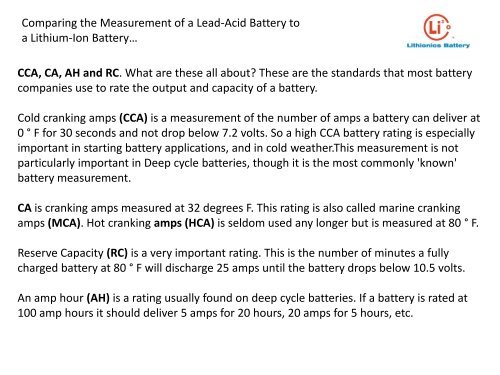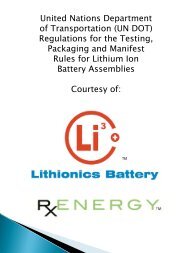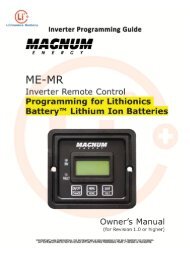How Do I Understand Cranking AMPS? - Lithionics Battery
How Do I Understand Cranking AMPS? - Lithionics Battery
How Do I Understand Cranking AMPS? - Lithionics Battery
You also want an ePaper? Increase the reach of your titles
YUMPU automatically turns print PDFs into web optimized ePapers that Google loves.
Comparing the Measurement of a Lead-Acid <strong>Battery</strong> to<br />
a Lithium-Ion <strong>Battery</strong>…<br />
CCA, CA, AH and RC. What are these all about These are the standards that most battery<br />
companies use to rate the output and capacity of a battery.<br />
Cold cranking amps (CCA) is a measurement of the number of amps a battery can deliver at<br />
0 ° F for 30 seconds and not drop below 7.2 volts. So a high CCA battery rating is especially<br />
important in starting battery applications, and in cold weather.This measurement is not<br />
particularly important in Deep cycle batteries, though it is the most commonly 'known'<br />
battery measurement.<br />
CA is cranking amps measured at 32 degrees F. This rating is also called marine cranking<br />
amps (MCA). Hot cranking amps (HCA) is seldom used any longer but is measured at 80 ° F.<br />
Reserve Capacity (RC) is a very important rating. This is the number of minutes a fully<br />
charged battery at 80 ° F will discharge 25 amps until the battery drops below 10.5 volts.<br />
An amp hour (AH) is a rating usually found on deep cycle batteries. If a battery is rated at<br />
100 amp hours it should deliver 5 amps for 20 hours, 20 amps for 5 hours, etc.
Comparing the Measurement of a Lead-Acid <strong>Battery</strong> to<br />
a Lithium-Ion <strong>Battery</strong>…<br />
Lithium-Ion is Designed to Run Between Minus 20 Degrees C and Plus 60 Degrees C<br />
Everyone Will Ask You for Our Cold <strong>AMPS</strong> or Cold <strong>Cranking</strong> <strong>AMPS</strong><br />
We measure our <strong>Cranking</strong> <strong>AMPS</strong> as ‘PCA 15’ and ‘PCA 30’<br />
First, a note: an engine start battery is required to deliver its power for 15 seconds, to turn<br />
the engine at 250 RPMS, with a voltage at or above 9.8V<br />
PCA15: The numbers of <strong>AMPS</strong> we will deliver for 15 seconds without affecting battery life<br />
PCA30: The numbers of <strong>AMPS</strong> we will deliver for 30 seconds without affecting battery life<br />
Conclusion: we will always deliver more <strong>AMPS</strong> with less VOLTAGE SAG than any battery,<br />
period.







